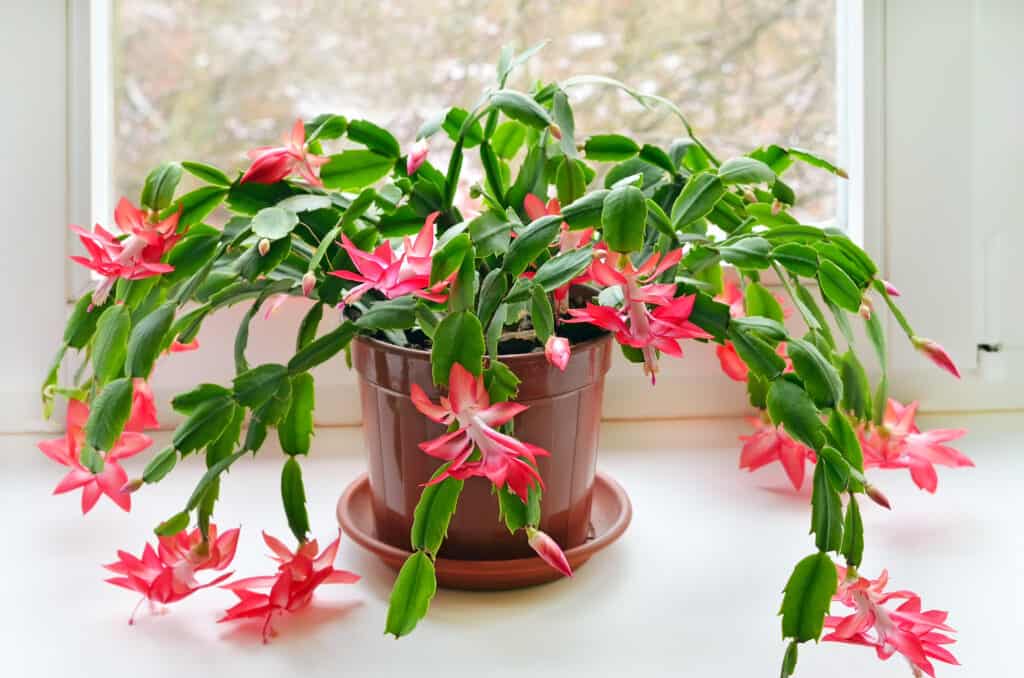Christmas cactus vs zygocactus are both beautiful, winter-blooming plants known for their pink flowers. They make lovely gifts and are an excellent addition to other common holiday plants, such as the poinsettia. These plants are very similar in shape, size, and colors and can also have similar flowers. Let’s explore these two wonderful plants’ similarities, differences and care practices!
| Christmas Cactus | Zygocactus | |
|---|---|---|
| Classification | Schlumbergera Buckleyi | Schlumbergera Truncata |
| Description | Smooth leaves, stems that bloom light pink flowers. | Jagged leaves, stems that bloom light pink flowers. |
| Bloom Time | November | December |
| Watering | Water only when the top two inches of soil feels dry | Water only when the top two inches of soil feels dry |
| Environment Needed | Warm and humid | Warm and humid |
What Are The Similarities Between Christmas Cactus vs Zygocactus?

Christmas Cactus and Zygocactus both belong to the Schlumbergera plant family.
©iStock.com/Nadezhda_Nesterova
There are many ways in which the Christmas cactus and the zygocactus are similar. Interestingly enough, they come from the same plant family, the Schlumbergera family. This plant family is relatively small, with only six to nine species known to it. All these species are native to Brazil and its rainforests in the south and southeast. They thrive in warm, humid environments and prefer indirect sunlight.
Often, cacti in the Schlumbergera family look different than their cousins found in deserts and other hot, dry climates. They have leaves and stems, from which bloom light pink or even lilac flowers.
Generally, care and maintenance for both plants are the same.
What are the Differences Between Christmas Cactus vs Zygocactus?

The zygocactus blooms in November.
©Akintevs/Shutterstock.com
Because they come from the same family, there aren’t many differences between these two plants. Essentially the main difference is bloom time. The zygocactus blooms in November, whereas the Christmas cactus blooms in December. In fact, the zygocactus is also known as the Thanksgiving cactus because it tends to bloom around the holiday. In contrast, the Christmas cactus’ begins to bloom around Christmas.
The only other main difference between these two plants is their leaves. The zygocactus has jagged leaves, whereas the leaves on a Christmas cactus are smooth along the edges.
What Kind of Light Do the Christmas Cactus and Zygocactus Need?
Both Christmas cactus and zygocactus do not do well in direct sunlight. Because of this, it’s best to keep them from windows facing to the south or the west. Suppose the light from a southern or western window is filtered somehow. In that case, if there are trees outside blocking the window or a sheer curtain hung up— it is possible to grow these plants near a southern or western window or windowsill.
For better plant growth, it is suggested to leave the plants in total darkness for at least twelve hours per day for the first six weeks of fall. This helps promote the blooming process.
How Should a Christmas Cactus and a Zygocactus be Watered?
Because they are used to humid climates, these cacti need to be watered more often than other cacti. Still, it is good to be wary of overwatering them. The best rule of thumb is to water these cacti only when the top inches of soil feel dry. When you water them, coat the soil evenly and thoroughly so that water reaches all parts of the roots.
What Kind of Soil Do the Christmas Cactus and Zygocactus Need?

Zygocactus does best in well-draining soil that can stay moist between watering.
©TSViPhoto/Shutterstock.com
Christmas cactus and zygocactus plants both require well-draining soil capable of staying a bit moist in between waterings. Any cactus soil mix of high quality will more than suffice for your zygocactus or Christmas cactus.
You can also give these plants fertilizer to help them grow. Dilute a small amount of liquid houseplant fertilizer and apply it to the soil of your zygocactus or Christmas cactus. You can do this every ten to fourteen days, but only when the plant is actively growing, in the spring, summer, and fall. In the late fall and early winter, when both plants are beginning to bloom, stop fertilizing the plants entirely.
What Kind of Environment Do Christmas Cactus and Zygocactus Need?
Since these plants are used to warm, humid environments, you may want to put them in rooms with a lot of humidity, like the kitchen or a bathroom. They also tend to thrive best in temperatures around 60 to 65 degrees Fahrenheit (15 – 18 degrees Celsius). However, as their blooming season approaches, you can always put them in a cooler room to promote the blooming process.
As a general rule of thumb, ensure that your Christmas cactus or zygocactus is away from any hot or cold drafts, like the furnace or air conditioning vents.
What are Some Other Tips for Taking Care of Christmas Cactus vs Zygocactus?
There are a lot of valuable tips to try to ensure you get the most out of your Christmas cactus or zygocactus.
When potting your Christmas cactus or zygocactus, make sure your cacti are in a pot with a drainage hole in the bottom, as this can aid the soil from getting and staying too wet. These cacti only need to be repotted every three years or whenever they outgrow their current pot.
You can prune these plants in the late spring or early summer to stimulate growth and blooming. All you have to do is cut off a few parts from each of the stems, and the plant will continue to grow.
Up Next:
- Easter Cactus vs Christmas Cactus: Is There a Difference?
- Christmas Cactus vs Thanksgiving Cactus: Is There a Difference?
The photo featured at the top of this post is © TSViPhoto/Shutterstock.com
Thank you for reading! Have some feedback for us? Contact the AZ Animals editorial team.







